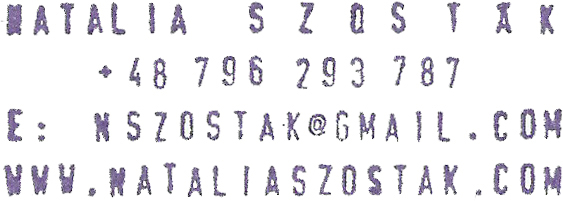 |
PL |
|||||
Aurelia Nowak, SanatoriumSANATORIUM is the result of a month long process based residency organized by Momentum in Kunstquartier Bethanien - a former hospital run by the Church since 1845, and currently a center for the arts. While working on this project with the artist, Natalia Szostak, the first question that came to my mind was: does art really have healing properties?
The creative process frequently happens to act as a therapeutic tool for artists. Throughout the history of art one encounters cases of brilliant artists who suffered from illnesses of both the body and the mind. Being afflicted with sickness they would find their motivation to create. The works created by many of them reflected their suffering and struggle with their weaknesses or loneliness. Art was a relief. It helped them to survive. It constituted the space in which they were able to pursue their passions. Paradoxically, both the critics and the artists feel uneasy talking about the therapeutic aspects of art. This topic is rather absent in the general discourse on art. This may be due to the unexplored and hard to predict effects of art therapy.
Contemplating the creative process as a tool helpful in health recovery dates back to 1938, when Adrian Hill, a British-based artist, came down with tuberculosis, which was very common at the time. During his stay in a sanatorium he discovered that artistic activity greatly accelerates the treatment process. It was as early as in 1939 that he introduced occupational therapy in one of the British sanatoriums. By working with patients he discovered that practicing art helps them to understand their own illness, heal their wounds, injuries and mental trauma. He also managed to convince sanatorium and hospital managers to allow paintings in their premises, which was followed by even being able to organize a series of art lectures for patients. Nowadays, the concept of an open studio has become a popular form of therapy using art.
For Szostak, her one-month residency is a time that she treats as a peculiar kind of a sanatorium stay. She lives and works at the hospital where nothing can distract her and she can be entirely focused on her work. Using various types of iconography, ranging from sacral, through portrait to natural environment imagery, her artistic work involves private experiences and mythologies. Working with memory, she processes memories and emotions into images. Over time this has become an integral part of her creative process. Creating seems to be a kind of transgression for her. It provides her with insight into herself and a way to cope with difficult transition moments in life.
When considering art as a therapeutic tool and in the context of the SANATORIUM project, it’s important to reference the works of three artists: Frida Kahlo, Alina Szapocznikow and Tracy Emin. Frequently referred to in the context of Szostak's works, Kahlo, bedridden in hospital, painted and tried to work through her trauma after an accident. Presenting her pain and disability in a visually moving way to this day influences the work of other artists. Suffering from cancer for many years, Alina Szapocznikow found art undoubtedly helpful in coping with this irreversible, terrifying process. On the other hand, the works of Tracy Emin constitute the most contemporary references to coping with loneliness, fears and sexuality.
Szostak's artistic work includes both anatomical analyses, studies of blood circulation, muscular or skeletal structure, studies of the brain, heart as well as family portraits, animals, forest scenes, hospital scenes, depiction of various stories or conditions still present in her memory. The relations between the sacred and the profane, scientific and metaphysical knowledge, between what is viewed as private and public are of extreme importance in their reception. The exhibition of her works as part of the SANATORIUM project provides a comprehensive overview of her artistic work. The cabinets of curiosities, as one of the main inspirations for the SANATORIUM exhibition, reflected the way in which reality was perceived by former rulers, aristocrats and collectors. As predecessors of contemporary museums they constituted a peculiar microcosm, where one could find anything: paintings, sculptures, medals, mandrake roots, curiosities, sacred objects... They were private collections available to only a few.
This is why the concept of the cabinets of curiosities have become so extremely important for us when preparing the exhibition as part of the open studio residency. While working and living in the gallery, Szostak reveals the process behind the creation of the exhibition. The existing works or those in the process of creation are available for everyone to visit and see. However, not everyone will be given the opportunity to hear the stories behind the work told by the artist. This gesture of opening the studio, yet leaving the contents of the works for just a few to discover, adds a very private dimension to the residency which may otherwise seem to leave very little room for privacy.
|
||||||
| SANATORIUM |